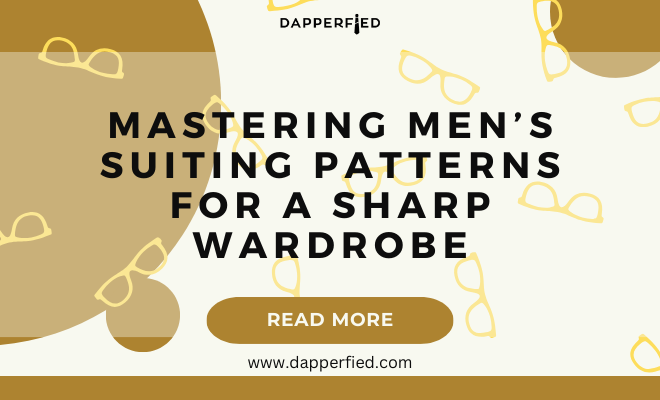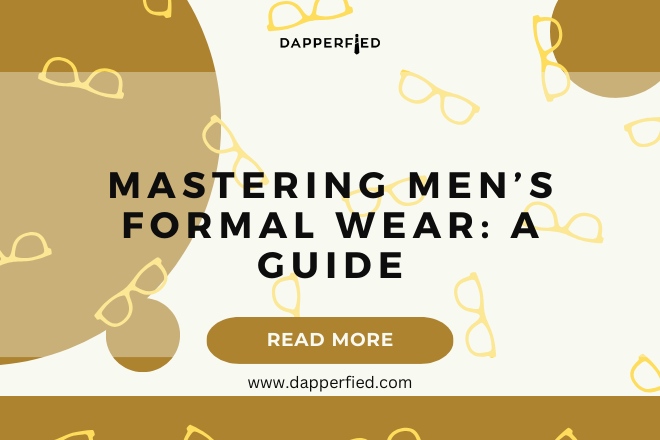
Men's Style
Mastering Men’s Suiting Patterns for a Sharp Wardrobe
Men’s suiting patterns have a rich history that dates back centuries. The evolution of men’s fashion has seen various patterns come and go, each with its own unique style and significance. From the classic pinstripes to bold checks and timeless solids, the choice of pattern can greatly impact the overall look and feel of a suit. It is important to choose the right pattern for the occasion, as it can convey a certain level of formality or casualness.
Key Takeaways
- Men’s suiting patterns can be overwhelming, but understanding the basics can help you make informed choices.
- When selecting a suit, consider the occasion, your body type, and the fit of the suit.
- Different suiting styles, such as single-breasted and double-breasted, can convey different levels of formality and style.
- Tailored suits are essential for a sharp and polished look, as they ensure a perfect fit and flattering silhouette.
- Mixing and matching patterns and accessories can elevate your suit game and add personality to your wardrobe.
Suit Selection Tips for a Sharp Wardrobe
When it comes to building a sharp wardrobe, there are several key factors to consider. First and foremost, the fit of the suit is crucial. A well-fitted suit can instantly elevate your style and make you look more put-together. It is important to choose a suit that flatters your body type and accentuates your best features.
In addition to fit, the choice of fabric is also important. Different fabrics have different characteristics and drape differently on the body. For a more formal look, opt for fabrics like wool or cashmere. For a more casual look, consider fabrics like linen or cotton.
Color coordination is another important aspect of suit selection. It is important to choose colors that complement your skin tone and hair color. Neutral colors like navy, gray, and black are versatile options that can be easily paired with different shirts and accessories.
Understanding Men’s Suiting Styles
When it comes to men’s suiting styles, there are two main categories: classic and modern. Classic styles are timeless and traditional, while modern styles are more contemporary and fashion-forward.
Single-breasted suits are the most common style and are characterized by a single row of buttons down the front. They are versatile and can be worn for both formal and casual occasions.
Double-breasted suits have two rows of buttons on the front and are known for their more formal and structured look. They are often worn for special occasions or in more conservative settings.
Lapel styles also play a role in the overall look of a suit. Notched lapels are the most common and versatile option, while peak lapels are more formal and sophisticated. Shawl lapels are typically found on tuxedos and have a more elegant and timeless look.
The Importance of Tailored Suits
| Metrics | Importance |
|---|---|
| Professionalism | A tailored suit can enhance one’s professional appearance and create a positive first impression. |
| Confidence | Wearing a well-fitted suit can boost one’s confidence and self-esteem. |
| Comfort | A tailored suit can provide greater comfort and ease of movement compared to off-the-rack suits. |
| Durability | A well-made tailored suit can last longer and withstand wear and tear better than cheaper alternatives. |
| Style | A tailored suit can be customized to fit one’s personal style and preferences, making it a unique and fashionable choice. |
A tailored suit can make all the difference in how you look and feel. A well-fitted suit can enhance your body shape, create a polished silhouette, and boost your confidence. It is important to find a skilled tailor who can make adjustments to ensure the suit fits you perfectly.
While tailored suits may come at a higher cost compared to off-the-rack options, the value they provide is unmatched. A well-tailored suit can last for years and can be worn for multiple occasions. It is an investment that pays off in terms of both style and longevity.
A Guide to Men’s Suiting Patterns
There are several common patterns found in men’s suiting, each with its own unique characteristics and style. Stripes, checks, and solids are among the most popular patterns.
Stripes, such as pinstripes or chalk stripes, are classic and timeless. They add a touch of sophistication to a suit and can elongate the body, making you appear taller and slimmer.
Checks, such as windowpane or houndstooth, are bolder and more eye-catching. They add visual interest to a suit and can be a great option for those looking to make a statement.
Solids, such as navy or gray, are versatile and timeless. They provide a clean and polished look that can be easily dressed up or down.
When choosing a pattern, it is important to consider your body type. Vertical stripes can elongate the body, while horizontal stripes can add width. Checks can be flattering for those with a leaner build, while solids can be more forgiving for those with a larger frame.

Mixing and matching patterns can also add a stylish and unique touch to your suit. However, it is important to keep the scale of the patterns in mind. Pairing a large-scale pattern with a small-scale pattern can create visual imbalance. It is best to choose patterns that are of similar scale or opt for a solid or neutral piece to balance out the look.
Suit Buying Tips for Men

When it comes to buying a suit, budget considerations are important. It is possible to find quality suits at different price points, so it is important to determine your budget and stick to it. It is also worth considering the cost per wear, as a well-made suit that lasts for years can be a better investment in the long run.
Shopping for sales can also help you find great deals on suits. Many retailers offer discounts during certain times of the year, so it is worth keeping an eye out for sales and promotions.
Deciding between online and in-store shopping is a personal preference. Online shopping offers convenience and a wider range of options, while in-store shopping allows you to try on suits and get personalized assistance from sales associates.
Mastering the Art of Mixing and Matching
Pairing suits with shirts and ties is an art form that can greatly enhance your overall look. When choosing a shirt, it is important to consider the color and pattern. A white or light blue shirt is a classic option that can be paired with almost any suit. For a more formal look, opt for a dress shirt with French cuffs.
When it comes to ties, consider the color and pattern as well. A solid tie in a complementary color is always a safe choice, but don’t be afraid to experiment with patterns and textures. Just make sure that the tie complements the suit and shirt, rather than overpowering them.
Accessorizing with pocket squares and cufflinks can add a touch of personality to your look. Pocket squares should complement the colors in your outfit, while cufflinks can be a subtle way to add a pop of style.
Accessorizing Your Suit for a Sharp Look
Choosing the right shoes is crucial when it comes to completing your suit ensemble. Oxfords or brogues in black or brown are classic options that can be worn with almost any suit. It is important to choose shoes that are well-made and comfortable, as they can greatly impact your overall comfort and confidence.
Belts and suspenders are also important accessories to consider. A belt should match the color of your shoes and should be made of high-quality leather. Suspenders can be a stylish alternative to belts and can add a touch of sophistication to your look.

Watches and other accessories, such as tie bars or lapel pins, can also enhance your overall style. A classic watch in silver or gold is a timeless option that can be worn with any suit. Tie bars should be discreet and should not overpower the tie or suit.
Men’s Formal Wear: Dressing for Special Occasions
When it comes to dressing for special occasions, it is important to understand the dress code. Black tie events typically require a tuxedo, while white tie events call for a tailcoat. It is important to adhere to the dress code to show respect for the occasion and the hosts.
For weddings and other events, it is important to consider the formality of the occasion. A dark suit is typically appropriate for most weddings, while more formal events may call for a tuxedo. It is always best to check with the hosts or consult the invitation for guidance on dress code.
While it is important to adhere to the dress code, there are still ways to stand out and add personal style to your look. Consider adding a unique pocket square or a statement tie to add a touch of personality without breaking the dress code.
Tips for Maintaining Your Suits for Longevity
Proper storage and cleaning are essential for maintaining the longevity of your suits. It is important to hang your suits on wooden or padded hangers to maintain their shape. Avoid overcrowding your closet, as this can cause wrinkles and damage to the fabric.
When it comes to cleaning, it is best to spot clean stains whenever possible. Dry cleaning should be done sparingly, as it can cause wear and tear on the fabric over time. It is best to follow the care instructions on the suit and consult a professional cleaner if needed.
By following these tips, you can ensure that your suits last for years to come and continue to look sharp and stylish.
In conclusion, men’s suiting patterns play a significant role in creating a sharp and stylish look. From classic pinstripes to bold checks and timeless solids, the choice of pattern can greatly impact the overall aesthetic of a suit. It is important to choose the right pattern for the occasion, taking into consideration factors such as body type and personal style.
In addition to pattern selection, other factors such as fit, fabric, and color coordination are also important when building a sharp wardrobe. Tailored suits offer numerous benefits in terms of fit and style, and finding the right tailor is crucial for achieving the perfect fit. While tailored suits may come at a higher cost, they provide unmatched value in terms of both style and longevity.
Accessorizing plays a key role in completing a suit ensemble, with shoes, belts, watches, and other accessories adding the finishing touches. Understanding dress codes for special occasions is also important, as it allows you to dress appropriately while still adding personal style. By following proper storage and cleaning techniques, you can ensure that your suits last for years to come.
In the end, the most important accessory is confidence. Experimenting with different styles and patterns can be a fun and exciting way to express your personal style and boost your confidence. With the right suit and accessories, you can create a sharp and stylish look that is sure to turn heads.
If you’re interested in learning more about the history of men’s suits, you should definitely check out this fascinating article on Dapperfied.com. It provides a brief overview of 1920s men’s suits and their significance in fashion history. From the iconic double-breasted styles to the emergence of new patterns and fabrics, this article delves into the evolution of men’s suiting during this era. Discover how these classic designs continue to influence modern fashion trends. To read more about it, click here.
FAQs
What are men’s suiting patterns?
Men’s suiting patterns refer to the different designs and styles of fabric used to make suits for men. These patterns can range from classic pinstripes to bold checks and plaids.
What are the most common men’s suiting patterns?
The most common men’s suiting patterns include pinstripes, herringbone, windowpane, glen plaid, and solid colors. Each pattern has its own unique look and can be worn for different occasions.
What is the difference between pinstripes and chalk stripes?
Pinstripes are thin, vertical stripes that are evenly spaced apart. Chalk stripes are wider and have a more irregular pattern, resembling the look of chalk lines on a blackboard.
What occasions are appropriate for wearing different suiting patterns?
Solid colors are appropriate for any occasion, while pinstripes and herringbone are more formal and suitable for business settings. Glen plaid and windowpane patterns are more casual and can be worn for less formal occasions.
What should I consider when choosing a suiting pattern?
When choosing a suiting pattern, consider the occasion, your personal style, and the fit of the suit. It’s important to choose a pattern that complements your body type and fits well to ensure a polished and professional look.


















